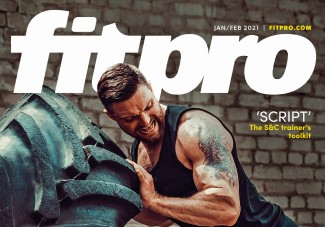Magazine References
Jan – Feb 2021

Pg 6 A tale of two pandemics
References
- Hamilton M (2018), The role of skeletal muscle contractile duration throughout the day: reducing sedentary time promoting universal physical activity in all people, J Physiol., 596(8): 1,331-40.
- Hamilton M, Hamilton DG (2004), Exercise physiology versus inactivity: an essential concept for understanding lipo-protein lipase regulation, Exerc Sport Sci Rev., 32: 161-6.
- Church T et al (2007), Effect of different doses of physical activity on cardiovascular fitness among sedentary, overweight or obese menopausal women with elevated blood pressure, a randomised controlled trial, JAMA, 297.
- Duvivier BM et al (2017), Breaking sitting time with light activities vs structured exercise. A randomised cross over study demonstrating benefits for glycaemic control and insulin sensitivity in type 2 diabetics, Diabetologia, 60: 490-8.
- Batman P (2020), NEAT Fit coaching program, http://www.neatfitcoaching.com.
- Bey C, Hamilton M (2003), Suppression of skeletal muscle lipo-protein lipase activity during physical inactivity: a molecular reason to maintain daily low intensity activity, Journal of Physiology, 300(551): 673-682
- Cregan-Reid V (2018), Primate Change: How the world we Made Changed us, first edition, London: Cassell.
Pg 14-16 How to age awesomely
References
- Ageing, Office of Statistics, https://www.ons.gov.uk/peoplepopulationandcommunity/birthsdeathsandmarriages/ageing, accessed on 27 November 2020.
- Thomas B (2013), Manual of Dietetic Practice, 4th Edition.
- Maggini S et al (2018), Immune function and micronutrient requirements change over the lifecourse, Nutrients, 10(19): 1-27.
- Shammas M (2011), Telomeres, lifestyle, cancer and aging, Curr Opin Clin Nutr Metab Care, 14(1): 28-34.
- Nettleton J (2008), Dietary patterns, good groups and telomere length in the Multi-Ethnic Study of Atherosclerosis (MESA), American Society for Clinical Nutrition.
- Ahola K et al (2012), Work-related exhaustion and telomere length: a population-based study, PLoS ONE, 7(7).
- Sadowska-Bartosz I (2014), Effect of antioxidant supplementation on aging and longevity, BioMed Research International.
- Richards J (2008), Higher serum vitamin D concentrations are associated with longer leukocyte telomere length in women, Am J Clin Nutr, 86(5).
- https://calerie.duke.edu/, accessed on 27 November 2020.
- Ravussin E et al (2015), A 2-year randomized controlled trial of human caloric restriction: feasibility and effects on predictors of health span and longevity, J Gerontol A Biol Sci Med Sci., 70(9): 1,097-104.
- Vina J (2016), Exercise: the lifelong supplement for healthy ageing and slowing down the onset of frailty, J Physiology, 15: 594.
- PHE publishes new advice on vitamin D – GOV.UK (www.gov.uk), accessed on 27 November 2020.
Raise the bar: Strength training for perimenopausal women
References
- Zurlo F, Larson K, Bogardus C, Ravussin E (1990), Skeletal muscle metabolism is a major determinant of resting energy expenditure, J Clin Invest., 86(5): 1,423-7.
- Henry CJ (2000), Mechanisms of changes in basal metabolism during ageing, Eur J Clin Nut., 54(3): S77-S97.
- Howe TE et al (2011), Exercise for preventing and treating osteoporosis in postmenopausal women, Cochrane Database Syst Rev., 6(7).
- Maltais ML, Desroches J, Dionne IJ (2009), Changes in muscle mass and strength after menopause, J Musculoskelet Neuronal Interact., 9(4): 186-97.
- Marzetti E et al (2017), Physical activity and exercise as countermeasures to physical frailty and sarcopenia, Aging Clin Exp Res., 29(1): 35-42.
- Koo S et al (2017), Obesity associates with vasomotor symptoms in postmenopause but with physical symptoms in perimenopause: a cross-sectional study, BMC Women’s Health, 17(1): 126.
- Lee CG, Carr MC, Murdoch SJ et al (2009), Adipokines, inflammation, and visceral adiposity across the menopausal transition: a prospective study, J Clin Endocrinol Metab., 94: 1104-10.
- Franklin RM, Ploutz-Snyder L, Kanaley JA (2009), Longitudinal changes in abdominal fat distribution with menopause, Metabolism, 58: 311-5.
- Christensen P et al (2018), Men and women respond differently to rapid weight loss: Metabolic outcomes of a multi-centre intervention study after a low-energy diet in 2500 overweight, individuals with pre-diabetes, Diabetes Obes Metab., 20(12): 2,840-51.
- Gordon BR et al (2018), Association of efficacy of resistance exercise training with depressive symptoms: meta-analysis and meta-regression analysis of randomized clinical trials, JAMA Psychiatry, 75(6): 566-76.
- Wilke J et al(2019), Acute effects of resistance exercise on cognitive function in healthy adults: a systematic review with multilevel meta-analysis, Sports Med., 49: 905-16.
Needs analysis toolkit for the S&C trainer
References
- Haff GG, Triplett NT (eds) (2015), Essentials of Strength Training and Conditioning, 4th edition, Human Kinetics.
- Hoffman J (2011), NSCA’s Guide to Program Design, Human Kinetics.
- Wing C (2018), Monitoring athlete load: data collection methods and practical recommendations, Strength & Conditioning Journal, 40(4): 26-39.
Eating disorders in 2021
References
- Mintel 2016, https://www.mintel.com/press-centre/food-and-drink/brits-lose-count-of-their-calories-over-a-third-of-brits-dont-know-how-many-calories-they-consume-on-a-typical-day
- Grodstein F, Levine R, Spencer T, Colditz GA, Stampfer MJ (1996), Three-year follow-up of participants in a commercial weight loss program: can you keep it off? Archives of Internal Medicine, 156(12): 1,302.
- Neumark-Sztainer D, Haines J, Wall M, Eisenberg M (2007), Why does dieting predict weight gain in adolescents? Findings from project EAT-II: a 5-year longitudinal study, Journal of the American Dietetic Association, 107(3): 448-55.
- Butterfly Foundation (2012), Paying the Price: The Economic and Social Impact of Eating Disorders in Australia,Melbourne: Butterfly Foundation.
- Termorshuizen JD, Watson HJ, Thornton LMet al (2020), Early impact of COVID‐19 on individuals with self‐reported eating disorders: a survey of ~1,000 individuals in the United States and the Netherlands, Int J Eat Disord.,1-11. doi: https://doi.org/10.1002/eat.23353, accessed on 8 October 2020.
Rehabilitating clients following total hip replacement surgery: Current evidence and recommendations
References
- Versus Arthritis. State of musculoskeletal health 2019. 2020 Available from https://www.versusarthritis.org/about-arthritis/data-and-statistics/state-of-musculoskeletal-health-2019/, accessed on 29 October 2020.
- Siopack JS, Jergesen HE (1995), Total hip arthroplasty, West J Med., 162(3): 243-9.
- National Joint Registry (2020), National Joint Registry 17th Annual Report 2020. Available from https://reports.njrcentre.org.uk/Downloads, accessed on 29 October 2020.
- Nuffield Health (2016), Rise of the active over 65s: Figures show those aged 72 are UK’s most regular gym users. Available from https://www.nuffieldhealth.com/article/rise-of-the-active-over-65s-figures-show-those-aged-72-are-uks-most-regular-gym-users, accessed on 29 October 2020.
- Wiles P (1958), The surgery of the osteoarthritic hip, Br J Surg., 45(193): 488-97.
- Learmonth ID, Young C, Rorabeck C (2007), The operation of the century: total hip replacement, Lancet, 370(9597): 1,508-19.
- Konopka JF, Lee YY, Su EP, McLawhorn AS (2018), Quality-Adjusted life years after hip and knee arthroplasty: health-related quality of life after 12,782 joint replacements, JB JS Open Access, 3(3): e0007.
- Kahlenberg CA, Nwachukwu BU, Schairer WW, Steinhaus ME, Cross MB (2017), Patient satisfaction reporting after total hip arthroplasty: A systematic review, Orthopedics, 40(3): e400-e4.
- Okoro T, Lemmey AB, Maddison P, Andrew JG (2012), An appraisal of rehabilitation regimes used for improving functional outcome after total hip replacement surgery, Sports Med Arthrosc Rehabil Ther Technol., 4(1): 5.
- Bandholm T, Wainwright TW, Kehlet H (2018), Rehabilitation strategies for optimisation of functional recovery after major joint replacement, J Exp Orthop., 5(1): 44.
- Jappinen AM, Munoz M, Kettunen T, Piirainen A (2020), Patients’ narratives of patient education in physiotherapy after total hip arthroplasty, Physiother Res Int., 25(4): e1862.
- National Institute of Health and Care Excellence (2020), NICE guideline [NG157] Joint replacement (primary): hip, knee and shoulder. Available from https://www.nice.org.uk/guidance/ng157, accessed on 29 October 2020.
- Wainwright TW, Burgess LC (2018), To what extent do current total hip and knee replacement patient information resources adhere to enhanced recovery after surgery principles?, Physiotherapy, 104(3): 327-37.
- Smith TO, Mansfield M, Dainty J, Hilton G, Mann CJV, Sackley CM (2018), Does physical activity change following hip and knee replacement? Matched case-control study evaluating Physical Activity Scale for the Elderly data from the Osteoarthritis Initiative, Physiotherapy, 104(1): 80-90.
- Smith TO, Latham S, Maskrey V, Blyth A (2015), Patients’ perceptions of physical activity before and after joint replacement: a systematic review with meta-ethnographic analysis, Postgrad Med J,. 91(1079): 483-91.
- Cioppa-Mosca JCJBC, Corradi-Scalise JT, Rudnick D, Wolff H (2006), Total Hip Arthroplasty Postsurgical RehabilitationGguidelines for the Orthopaedic Clinician, Missouri Mosby Elsevier, 4-16.
- Madara KC, Marmon A, Aljehani M, Hunter-Giordano A, Zeni J, Jr., Raisis L (2019), Progressive rehabilitation after total hip arthroplasty: A pilot and feasibility study, Int J Sports Phys Ther., 14(4): 564-81.
- National Strength & Conditioning Association (NSCA), Jacobs P (2017), Understanding and Recommending the Exercise for Clients with Joint Replacements. NSCA’S Essentials of Training Special Population, Human Kinetics.
- Snell D, Hipango J, Sinnott KA, Dunn JA, Rothwell A, Hsieh CJ et al (2018), Rehabilitation after total joint replacement: a scoping study, Disabil Rehabil., 40(14): 1,718-31.
- Andrews JRH, Wilk KE (2012), Physical Rehabilitation of the Injured Athlete, 4th edition, Cambridge: Elsevier.


